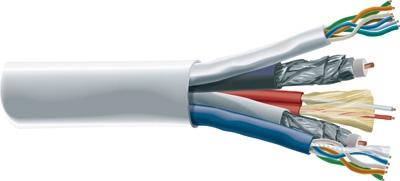The Custom Installer: The Little Cable That Can

Like most S&V readers, I was excited by January's feature story called "50 Greatest A/V Innovations." How could any red-blooded techie not be sucked in by a title like that? But, as with all lists, this one included and excluded some choices that were debatable - and I'm going to weigh in on one of the biggest omissions.
Of all the technologies from the past 50 years, one of the most powerful (and apparently un-listworthy) comes in the form of a humble wire: the Category-rated cable. In a world where wireless is all the rage, a structured-wiring backbone remains the highway that carries the vast majority of signals throughout a home.
Running Category-rated cabling is almost synonymous with being a custom installer. Beyond its amazing ability to transfer all types of data, one of the most shocking things about this cabling is its incredibly low price. Whereas short lengths of audio and video cables can cost hundreds, even thousands of dollars, this unassuming workhorse typically goes for less than 25¢ a foot. And though it's smaller in diameter than a No. 2 pencil, Category 5's 24-gauge wiring is a color-coded marvel. When you consider just how powerful and complex this wire is, it's staggering that you can buy it for less than the price of a pack of gum. In fact, it's so cheap that I use leftover pieces to tie up yard debris! (It tickles me to no end to think that our bundle of tree branches is the most technologically advanced in the neighborhood.)
Category-rated cabling has seen many changes since its inception, but by far the most well-known and prevalent version is Category 5 (Cat-5), with Cat-5e (enhanced) being the current TIA/EIA-568-B standard. Cat-5e can pass 100-MHz signals up to 300 feet - whereas Cat-6, the next-gen standard, will send 250-MHz signals up to 100 meters, and Cat-6a (augmented) will send 500 MHz across the same distance. As we get into HD video on demand and shuttling multiple 1080p streams around our homes, these cables will be the vital links in the gigabit chain.
For years, installers used Cat-5 as a high-end solution for wiring phones and doorbells. Since a single run can carry up to four phone lines and is incredibly resistant to noise from one line bleeding into another, Cat-5 was perfect for the multi-line phone/fax/dial-up scenarios of yesteryear. But then the Internet boom came along, and all those people whose homes had been prewired with Cat-5 suddenly found themselves in the enviable position of being network-ready. Today, the ginormous amount of data flowing through Cat-5 pipelines inside homes is staggering.
Cat-5 is now also being called into action to carry low-voltage signals of all types, like those from housewide audio-system controllers. Without Cat-5, keypad controls from companies like Elan, Niles, Sonance, NuVo, ZoN, ReQuest, and others would cease to work. And IP-based companies like Net- Streams, Colorado vNet, and Control 4 probably wouldn't even exist!
The use of baluns (which take balanced signals and convert them to unbalanced) has allowed Cat-5 applications to continue to advance. For instance, there are baluns for sending audio and video signals over Cat-5, including HD signals up to 1,000 feet and even computer VGA signals. More recently, baluns have been introduced for carrying USB as well as HDMI. Because of its low cost and high bandwidth, Cat-5 is practically the perfect medium for transmitting video signals.
When I started in custom installation 10 years ago, our company specified Cat-5 for all wiring applications. Honestly, I didn't really understand its power and potential. But I can't tell you how many times that wiring infrastructure has come to the rescue, enabling the customer to add some new feature or ability to the system without a costly retrofit. Now Cat-5 has gone mainstream, and even electricians and builders are specifying it.
Since convergence is finally here, more and more products requiring high-speed network access will be finding their way into countless homes, with the Web as the content-delivery portal. And what will be the fiber that delivers the goods while holding that big Web together? Category-rated cable. Sounds pretty darn innovative to me!
Back to Custom Installer Main Back to Homepage What's New on S&V













































